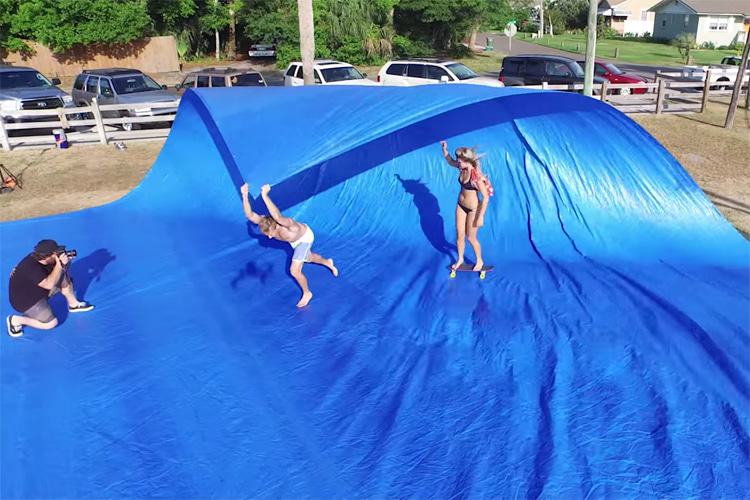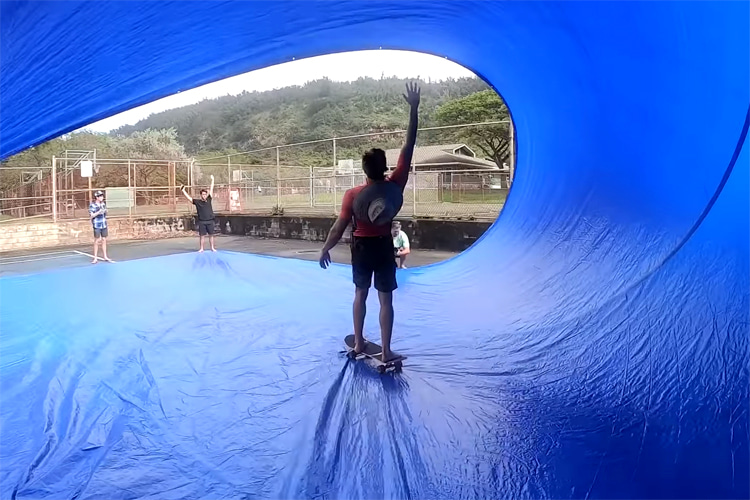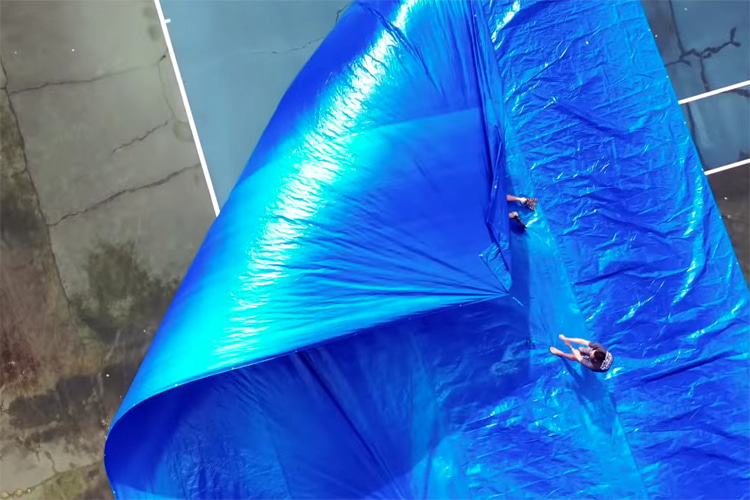The not-so-ancient art of tarp surfing saw the light of the day for the first in the mid-1990s in California.
But the outdoor practice that mimics tube riding on terra firma didn’t capture the heart of many fans, so the trend was frozen for nearly two decades.
Around 2010, a group of surfers and skateboarders made a few improvements to the artificial wave, and social media did the rest.
Nic Lamb, Homer Henard, Omar Etcheverry, and Chris Killen’s YouTube video quickly reached a million views, and the rest is history.
Using IKEA bags made from 100 percent polypropylene, tarp surfers are able to create huge blue cylinders and get barreled on them using a longboard or standard skateboard.
But they can also try inline skates, surfboards with wheels, bikes, and stand up paddle skateboards to make it look crazier.


Materials and Human Resources
Tarp surfing requires two very important assets: the largest possible tarp – preferably blue – and a couple of friends.
The bigger, stronger, and more flexible the blue sheet is, the more spectacular the experience will be.
Get an affordable, high-quality, heavy-duty blue tarp and apply, if possible, a few aluminum grommets on the corners for making pulling easier.
A 4.5-ounce, six-mil high-density woven polyethylene tarp with rope reinforced corners for added strength will work perfectly fine.
Ideally, design or get a rectangular-shaped waterproof or water-resistant tarp.
The goal is to produce a flawless tunnel vision, extend tube time, and allow the tarp pit rider to exit the pit without getting… wet?
You can create small, medium, and large barrels that break slower or fast. It all depends on the type of tarp surfing experience you wish to stage.
And remember: there might be a few closeouts, too.


Tarp Surfer’s Technique
Once you’ve gathered your friends and laid the tarp on the ground, it’s time to create the perfect hollow wave and pull into slabs.
Here’s how you should approach a tarp pit:
1. As the wave begins to peel down the line, skate toward the back of the pit at medium speed – timing is everything;
2. Adopt a low stance as you backdoor the barrel to avoid wiping out;
3. Try to ride across the tarp diagonally to increase tube time;
If you wish to get tarp surfing to the next level, try paddling for a wave or towing into it.
For instance, lay down on top on a surfboard with wheels and try to catch the wave and stand up as the lip begins to throw over forward.
Tarp surfing is a teamwork sport. But there might be surprises.


The Wavemakers’ Technique
The wavemakers are expected to let you ride the barrel of your life, but they can also mess things up and force a nasty wipeout.
For those responsible for creating the ultimate tarp surfing wave, here’s what should be done:
1. Stretch out the rectangular tarp on a flat and smooth surface – a parking lot is an excellent option;
2. Place three medium-weight objects on the far corners of the breaking wave to make sure the tarp doesn’t get picked up by the wind;
3. Grab the corner of the tarp that is closest to the surfer’s entrance;
4. Raise your arm straight above the head and run toward the center of the widest side of the tarp;
5. Adjust the wave’s breaking speed according to the surfer’s motion and the wind conditions;
For a spectacular, eye-catching experience, set up a night tarp surfing session using handheld searchlights placed behind the blue curtain.




Recent Comments